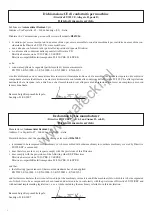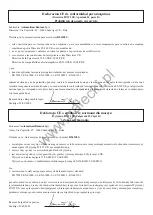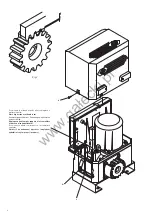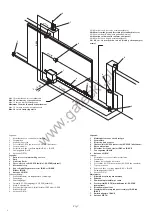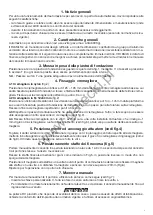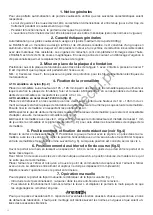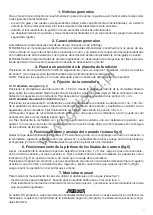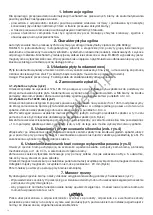
10
11
1. General information
For an efficient operation of the sliding automatic mechanism, the gate must have the following features:
- The guide rail and its wheels must be suitable in size and mantained to prevent gate from excessive sliding
friction.
- When running, gate must not rock excessively.
- Opening and closing stroke must be regulated by a mechanical limit stop (to safety standard in force).
2. General features
Automation for private use sliding gates (max. gate weight 600Kg).
The small and elegant design enbloc RI.6MLS consists of a painted aluminium unit containing the motor and
irreversible reduction unit, realized with high-grade materials. The reduction parts are completely immersed
in oil. The RI.6MLS is equipped with magnetic limit switches
.
A personalized key emergency release enables manual gate operation in the event of power failure.
3. Foundation slab laying
Secure the foundation slab to the ground with no. 4 steel T pressure inserts to dimensions given in fig. 1 (it’s
important the slab is securely fastened to the ground).
N.B.: Go through holes F with a sheath suitable to the actuator feed cables.
4. Rack fixing
4.1 Nylon rack (fig. 2)
Place the rack at a height of 125 ÷ 126 mm from the base of the foundation slab up to the rack tooth head;
drill and thread M6 the gate approx. in the center line between the rack slots. Now secure the rack and refer
to points 4.3 and 4.4 before proceeding.
4.2 Fe 12x30 mm rack (fig. 2)
Weld or screw the spacer pins D onto the gate at 144 ÷ 145 mm above the base of the foundation actuator
slab and maintain the same pitch as the rack drilling. Now secure the rack and refer to points 4.3 and 4.4
before proceeding.
4.3
Keep the pitch of teeth between the two parts of the rack; the joining with another piece of rack would
make it easier to achieve (see fig. 2)
4.4
Secure the rack with the screws V making sure, once the actuator has been installed, that between rack
and the drive gear there is always approx. 1 mm clearance (see fig. 3); to get this clearance use the slots on
the rack.
5. Actuator positioning and fixing (see fig. 4)
Remove the case by untightening the screws V. Place the actuator unit so that the gear is centered to the
rack; level it with the grains G and if necessary adjust the clearance between rack and gears (according to
fig. 3). Now tighten the screws L.
6. Limit stop flask positioning (see fig. 5)
Open manually the gate and leave approximately of 1÷3 cm, depending on gate weight, between gate and
positive mechanical stop A.
Using the dowels provided, secure the limit switch bracket as shown in Fig. 5, in reversed position, so that
the bracket will not stick out of the rack.
Position the magnet to the bracket and after you have located the sensor’s switch point, secure the magnet
to the bracket with a screw. The gap between magnet and sensor should not exceed 20mm (Fig.6).
Repeat the procedure with door closing.
7. Manual operation
To operate the gate manually, use the release as follows (see fig. 7):
- once inserted the personalized key C, turn it anticlockwise and pull the lever L.
- to reset the standard operation running, close the lever L and operate the gate manually, until engage-
ment.
CAUTION
The civil liability policy, which covers possible injuries to people or accidents caused by defects in construction,
requires the system to be to existing standard and to use original Benincà accessories.
www.ga
ł
ecki.pl


